Employee Engagement: Strategies and Organizational Benefits Report
VerifiedAdded on 2022/08/08
|19
|5300
|15
Report
AI Summary
This report provides a comprehensive analysis of employee engagement, exploring its concept, dimensions, and components. It examines the need for employee engagement, highlighting its importance in today's competitive market. The report delves into the principal drivers of employee engagement, such as feeling valued, involvement in decision-making, and concern for employee well-being, as well as the benefits for both employees and the organization. The application of employee engagement through job design, including discretionary behavior, organizational citizenship, and role autonomy, is discussed. The report also covers diagnostic tools for measuring employee engagement, including surveys, focus groups, and HR matrices. Furthermore, it explores employee value propositions, providing an example from Google. Finally, the report suggests major HR strategies to enhance employee engagement, such as effective communication, employee empowerment, appreciation, and employee motivation, while also addressing potential barriers. The report concludes with a summary of the key findings and recommendations for fostering a highly engaged workforce.
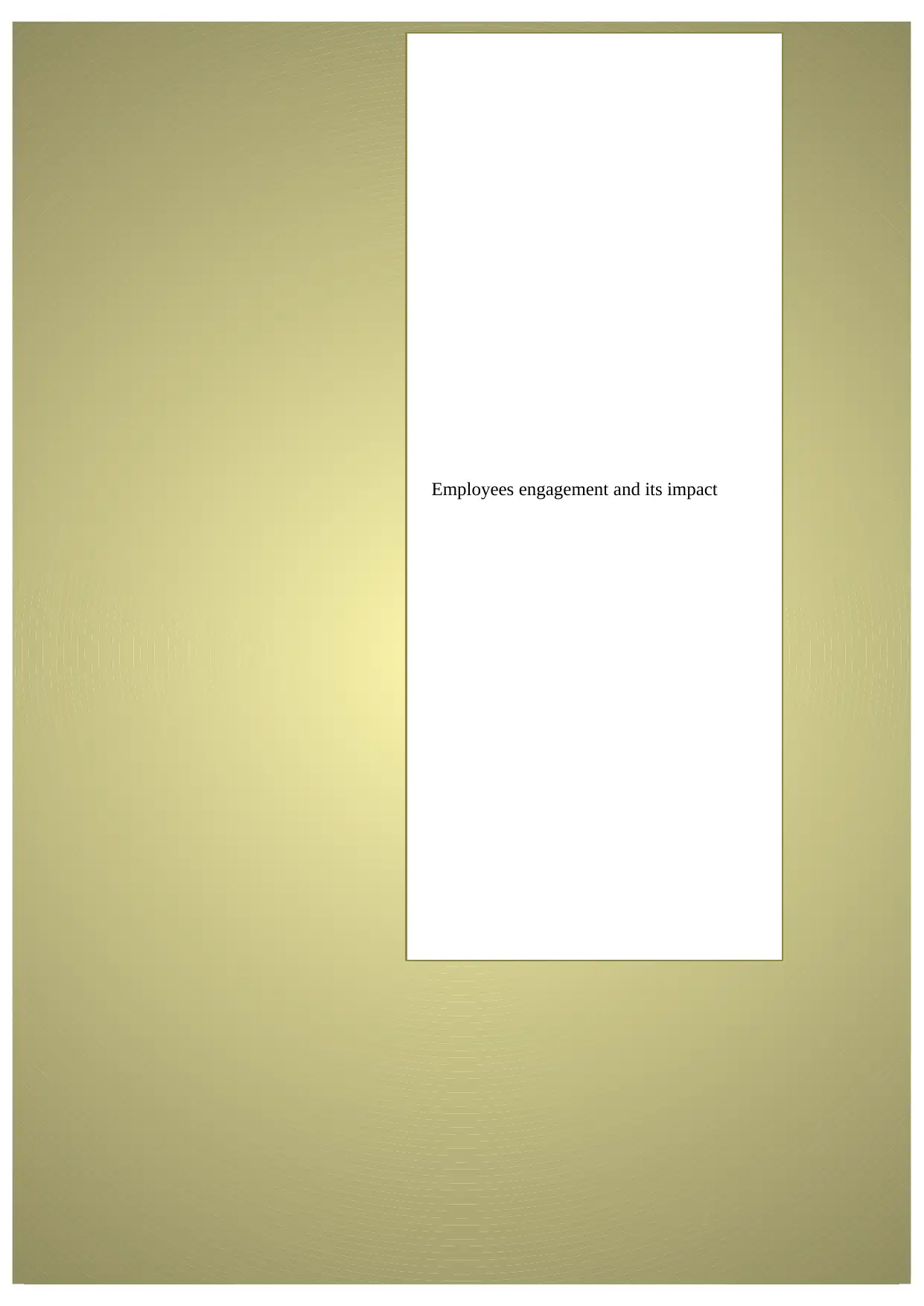
Employees engagement and its impact
Paraphrase This Document
Need a fresh take? Get an instant paraphrase of this document with our AI Paraphraser
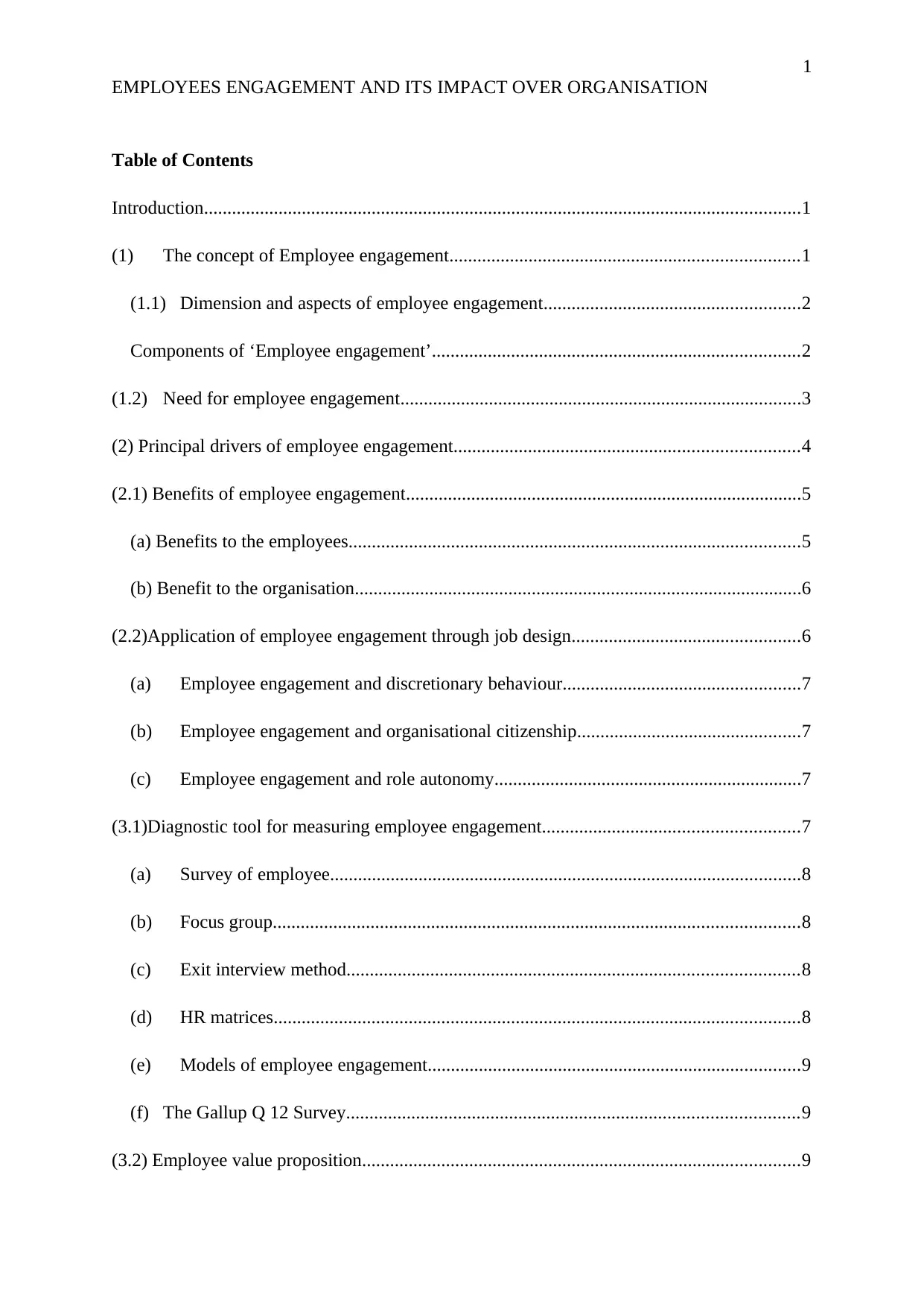
1
EMPLOYEES ENGAGEMENT AND ITS IMPACT OVER ORGANISATION
Table of Contents
Introduction................................................................................................................................1
(1) The concept of Employee engagement...........................................................................1
(1.1) Dimension and aspects of employee engagement.......................................................2
Components of ‘Employee engagement’...............................................................................2
(1.2) Need for employee engagement......................................................................................3
(2) Principal drivers of employee engagement..........................................................................4
(2.1) Benefits of employee engagement.....................................................................................5
(a) Benefits to the employees.................................................................................................5
(b) Benefit to the organisation................................................................................................6
(2.2)Application of employee engagement through job design.................................................6
(a) Employee engagement and discretionary behaviour...................................................7
(b) Employee engagement and organisational citizenship................................................7
(c) Employee engagement and role autonomy..................................................................7
(3.1)Diagnostic tool for measuring employee engagement.......................................................7
(a) Survey of employee.....................................................................................................8
(b) Focus group.................................................................................................................8
(c) Exit interview method.................................................................................................8
(d) HR matrices.................................................................................................................8
(e) Models of employee engagement................................................................................9
(f) The Gallup Q 12 Survey.................................................................................................9
(3.2) Employee value proposition..............................................................................................9
EMPLOYEES ENGAGEMENT AND ITS IMPACT OVER ORGANISATION
Table of Contents
Introduction................................................................................................................................1
(1) The concept of Employee engagement...........................................................................1
(1.1) Dimension and aspects of employee engagement.......................................................2
Components of ‘Employee engagement’...............................................................................2
(1.2) Need for employee engagement......................................................................................3
(2) Principal drivers of employee engagement..........................................................................4
(2.1) Benefits of employee engagement.....................................................................................5
(a) Benefits to the employees.................................................................................................5
(b) Benefit to the organisation................................................................................................6
(2.2)Application of employee engagement through job design.................................................6
(a) Employee engagement and discretionary behaviour...................................................7
(b) Employee engagement and organisational citizenship................................................7
(c) Employee engagement and role autonomy..................................................................7
(3.1)Diagnostic tool for measuring employee engagement.......................................................7
(a) Survey of employee.....................................................................................................8
(b) Focus group.................................................................................................................8
(c) Exit interview method.................................................................................................8
(d) HR matrices.................................................................................................................8
(e) Models of employee engagement................................................................................9
(f) The Gallup Q 12 Survey.................................................................................................9
(3.2) Employee value proposition..............................................................................................9
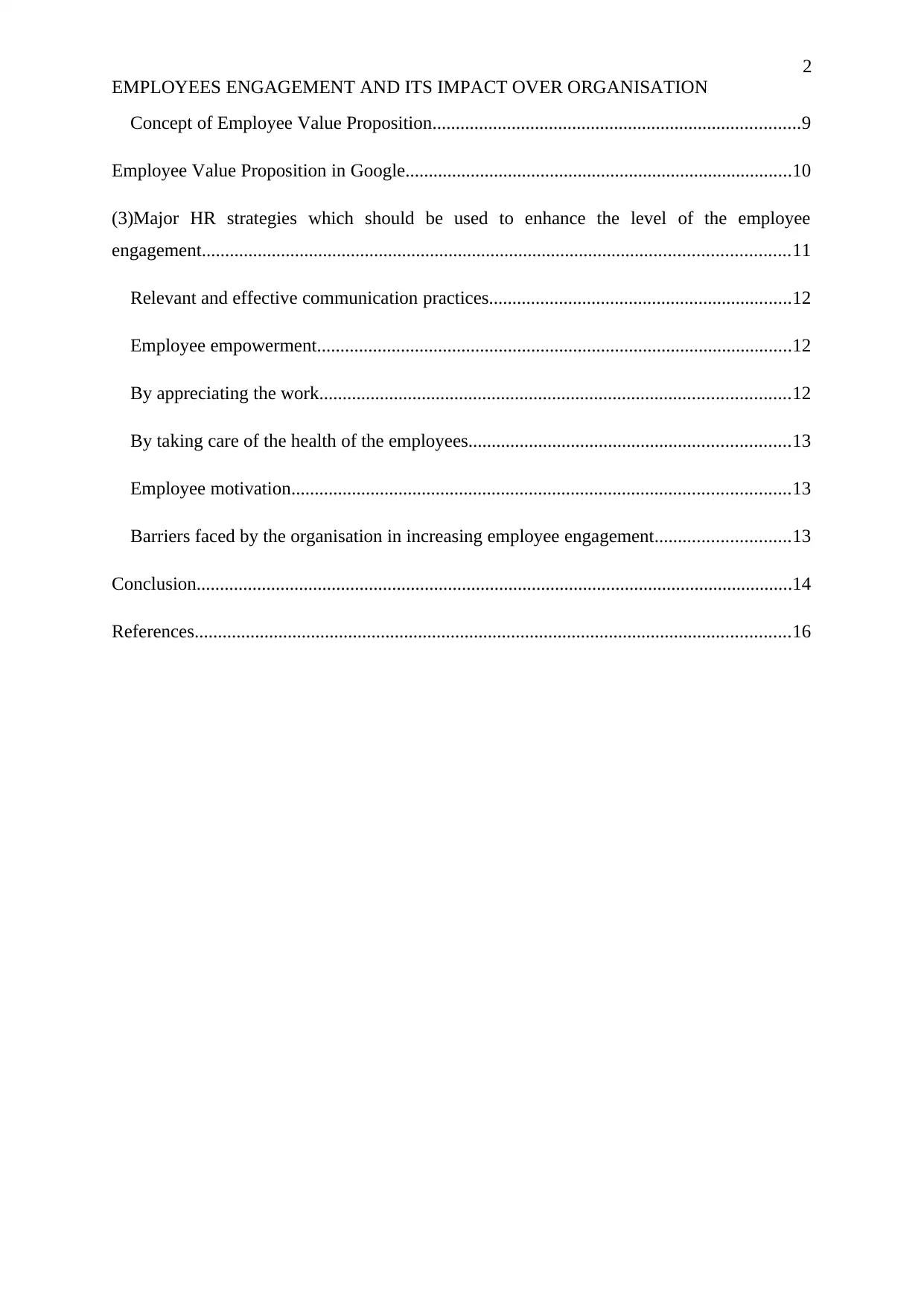
2
EMPLOYEES ENGAGEMENT AND ITS IMPACT OVER ORGANISATION
Concept of Employee Value Proposition...............................................................................9
Employee Value Proposition in Google...................................................................................10
(3)Major HR strategies which should be used to enhance the level of the employee
engagement..............................................................................................................................11
Relevant and effective communication practices.................................................................12
Employee empowerment......................................................................................................12
By appreciating the work.....................................................................................................12
By taking care of the health of the employees.....................................................................13
Employee motivation...........................................................................................................13
Barriers faced by the organisation in increasing employee engagement.............................13
Conclusion................................................................................................................................14
References................................................................................................................................16
EMPLOYEES ENGAGEMENT AND ITS IMPACT OVER ORGANISATION
Concept of Employee Value Proposition...............................................................................9
Employee Value Proposition in Google...................................................................................10
(3)Major HR strategies which should be used to enhance the level of the employee
engagement..............................................................................................................................11
Relevant and effective communication practices.................................................................12
Employee empowerment......................................................................................................12
By appreciating the work.....................................................................................................12
By taking care of the health of the employees.....................................................................13
Employee motivation...........................................................................................................13
Barriers faced by the organisation in increasing employee engagement.............................13
Conclusion................................................................................................................................14
References................................................................................................................................16
⊘ This is a preview!⊘
Do you want full access?
Subscribe today to unlock all pages.

Trusted by 1+ million students worldwide
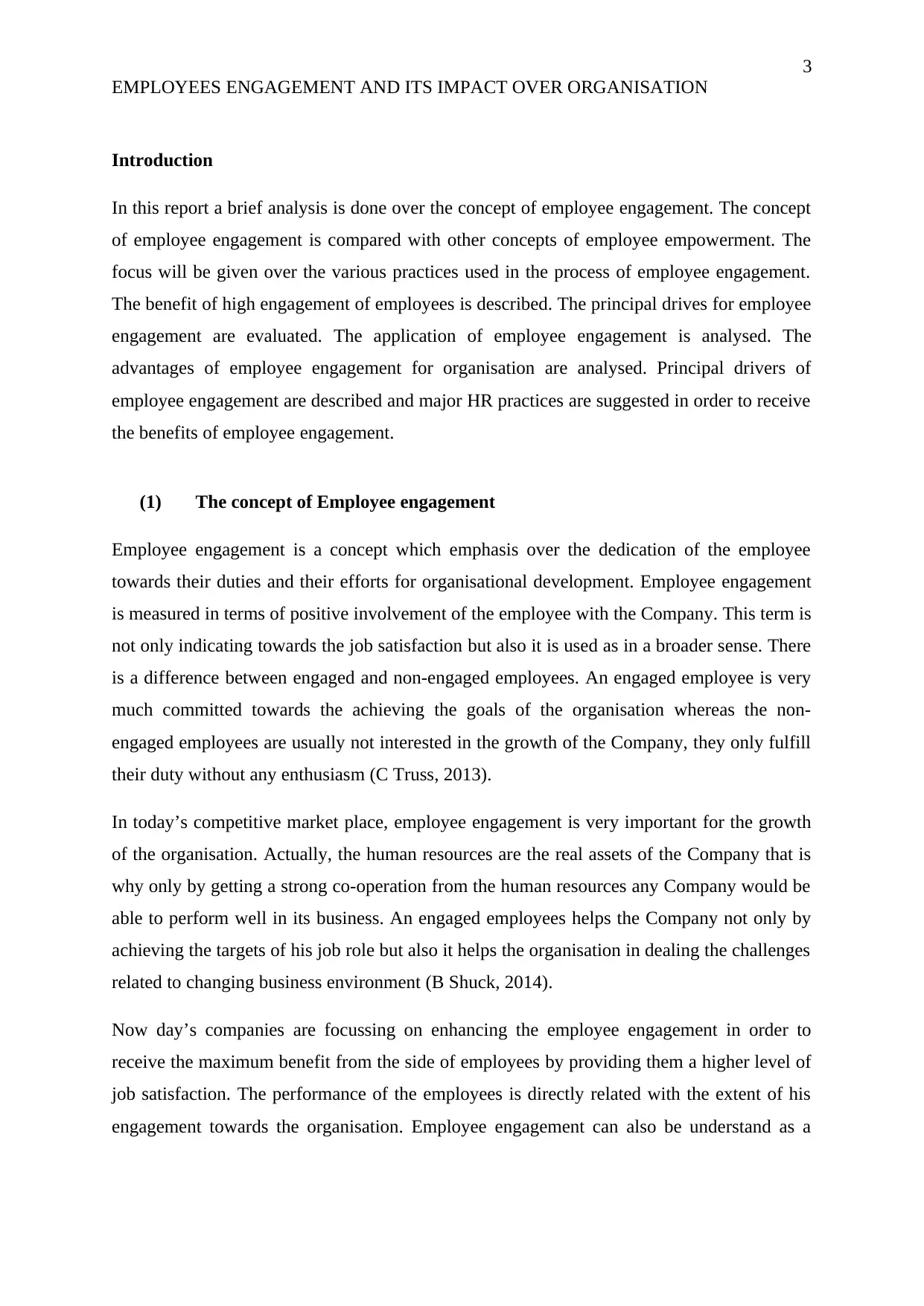
3
EMPLOYEES ENGAGEMENT AND ITS IMPACT OVER ORGANISATION
Introduction
In this report a brief analysis is done over the concept of employee engagement. The concept
of employee engagement is compared with other concepts of employee empowerment. The
focus will be given over the various practices used in the process of employee engagement.
The benefit of high engagement of employees is described. The principal drives for employee
engagement are evaluated. The application of employee engagement is analysed. The
advantages of employee engagement for organisation are analysed. Principal drivers of
employee engagement are described and major HR practices are suggested in order to receive
the benefits of employee engagement.
(1) The concept of Employee engagement
Employee engagement is a concept which emphasis over the dedication of the employee
towards their duties and their efforts for organisational development. Employee engagement
is measured in terms of positive involvement of the employee with the Company. This term is
not only indicating towards the job satisfaction but also it is used as in a broader sense. There
is a difference between engaged and non-engaged employees. An engaged employee is very
much committed towards the achieving the goals of the organisation whereas the non-
engaged employees are usually not interested in the growth of the Company, they only fulfill
their duty without any enthusiasm (C Truss, 2013).
In today’s competitive market place, employee engagement is very important for the growth
of the organisation. Actually, the human resources are the real assets of the Company that is
why only by getting a strong co-operation from the human resources any Company would be
able to perform well in its business. An engaged employees helps the Company not only by
achieving the targets of his job role but also it helps the organisation in dealing the challenges
related to changing business environment (B Shuck, 2014).
Now day’s companies are focussing on enhancing the employee engagement in order to
receive the maximum benefit from the side of employees by providing them a higher level of
job satisfaction. The performance of the employees is directly related with the extent of his
engagement towards the organisation. Employee engagement can also be understand as a
EMPLOYEES ENGAGEMENT AND ITS IMPACT OVER ORGANISATION
Introduction
In this report a brief analysis is done over the concept of employee engagement. The concept
of employee engagement is compared with other concepts of employee empowerment. The
focus will be given over the various practices used in the process of employee engagement.
The benefit of high engagement of employees is described. The principal drives for employee
engagement are evaluated. The application of employee engagement is analysed. The
advantages of employee engagement for organisation are analysed. Principal drivers of
employee engagement are described and major HR practices are suggested in order to receive
the benefits of employee engagement.
(1) The concept of Employee engagement
Employee engagement is a concept which emphasis over the dedication of the employee
towards their duties and their efforts for organisational development. Employee engagement
is measured in terms of positive involvement of the employee with the Company. This term is
not only indicating towards the job satisfaction but also it is used as in a broader sense. There
is a difference between engaged and non-engaged employees. An engaged employee is very
much committed towards the achieving the goals of the organisation whereas the non-
engaged employees are usually not interested in the growth of the Company, they only fulfill
their duty without any enthusiasm (C Truss, 2013).
In today’s competitive market place, employee engagement is very important for the growth
of the organisation. Actually, the human resources are the real assets of the Company that is
why only by getting a strong co-operation from the human resources any Company would be
able to perform well in its business. An engaged employees helps the Company not only by
achieving the targets of his job role but also it helps the organisation in dealing the challenges
related to changing business environment (B Shuck, 2014).
Now day’s companies are focussing on enhancing the employee engagement in order to
receive the maximum benefit from the side of employees by providing them a higher level of
job satisfaction. The performance of the employees is directly related with the extent of his
engagement towards the organisation. Employee engagement can also be understand as a
Paraphrase This Document
Need a fresh take? Get an instant paraphrase of this document with our AI Paraphraser
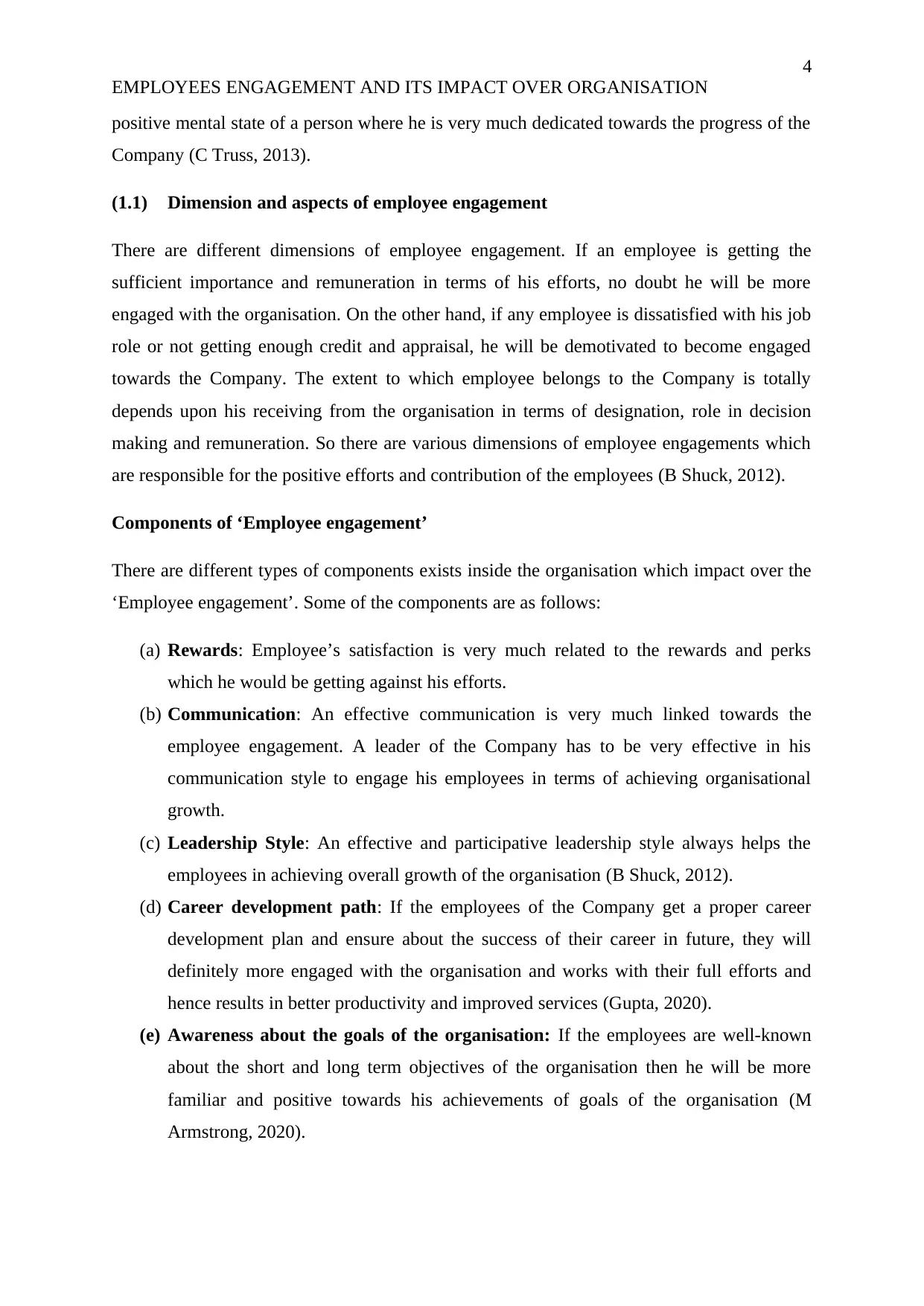
4
EMPLOYEES ENGAGEMENT AND ITS IMPACT OVER ORGANISATION
positive mental state of a person where he is very much dedicated towards the progress of the
Company (C Truss, 2013).
(1.1) Dimension and aspects of employee engagement
There are different dimensions of employee engagement. If an employee is getting the
sufficient importance and remuneration in terms of his efforts, no doubt he will be more
engaged with the organisation. On the other hand, if any employee is dissatisfied with his job
role or not getting enough credit and appraisal, he will be demotivated to become engaged
towards the Company. The extent to which employee belongs to the Company is totally
depends upon his receiving from the organisation in terms of designation, role in decision
making and remuneration. So there are various dimensions of employee engagements which
are responsible for the positive efforts and contribution of the employees (B Shuck, 2012).
Components of ‘Employee engagement’
There are different types of components exists inside the organisation which impact over the
‘Employee engagement’. Some of the components are as follows:
(a) Rewards: Employee’s satisfaction is very much related to the rewards and perks
which he would be getting against his efforts.
(b) Communication: An effective communication is very much linked towards the
employee engagement. A leader of the Company has to be very effective in his
communication style to engage his employees in terms of achieving organisational
growth.
(c) Leadership Style: An effective and participative leadership style always helps the
employees in achieving overall growth of the organisation (B Shuck, 2012).
(d) Career development path: If the employees of the Company get a proper career
development plan and ensure about the success of their career in future, they will
definitely more engaged with the organisation and works with their full efforts and
hence results in better productivity and improved services (Gupta, 2020).
(e) Awareness about the goals of the organisation: If the employees are well-known
about the short and long term objectives of the organisation then he will be more
familiar and positive towards his achievements of goals of the organisation (M
Armstrong, 2020).
EMPLOYEES ENGAGEMENT AND ITS IMPACT OVER ORGANISATION
positive mental state of a person where he is very much dedicated towards the progress of the
Company (C Truss, 2013).
(1.1) Dimension and aspects of employee engagement
There are different dimensions of employee engagement. If an employee is getting the
sufficient importance and remuneration in terms of his efforts, no doubt he will be more
engaged with the organisation. On the other hand, if any employee is dissatisfied with his job
role or not getting enough credit and appraisal, he will be demotivated to become engaged
towards the Company. The extent to which employee belongs to the Company is totally
depends upon his receiving from the organisation in terms of designation, role in decision
making and remuneration. So there are various dimensions of employee engagements which
are responsible for the positive efforts and contribution of the employees (B Shuck, 2012).
Components of ‘Employee engagement’
There are different types of components exists inside the organisation which impact over the
‘Employee engagement’. Some of the components are as follows:
(a) Rewards: Employee’s satisfaction is very much related to the rewards and perks
which he would be getting against his efforts.
(b) Communication: An effective communication is very much linked towards the
employee engagement. A leader of the Company has to be very effective in his
communication style to engage his employees in terms of achieving organisational
growth.
(c) Leadership Style: An effective and participative leadership style always helps the
employees in achieving overall growth of the organisation (B Shuck, 2012).
(d) Career development path: If the employees of the Company get a proper career
development plan and ensure about the success of their career in future, they will
definitely more engaged with the organisation and works with their full efforts and
hence results in better productivity and improved services (Gupta, 2020).
(e) Awareness about the goals of the organisation: If the employees are well-known
about the short and long term objectives of the organisation then he will be more
familiar and positive towards his achievements of goals of the organisation (M
Armstrong, 2020).
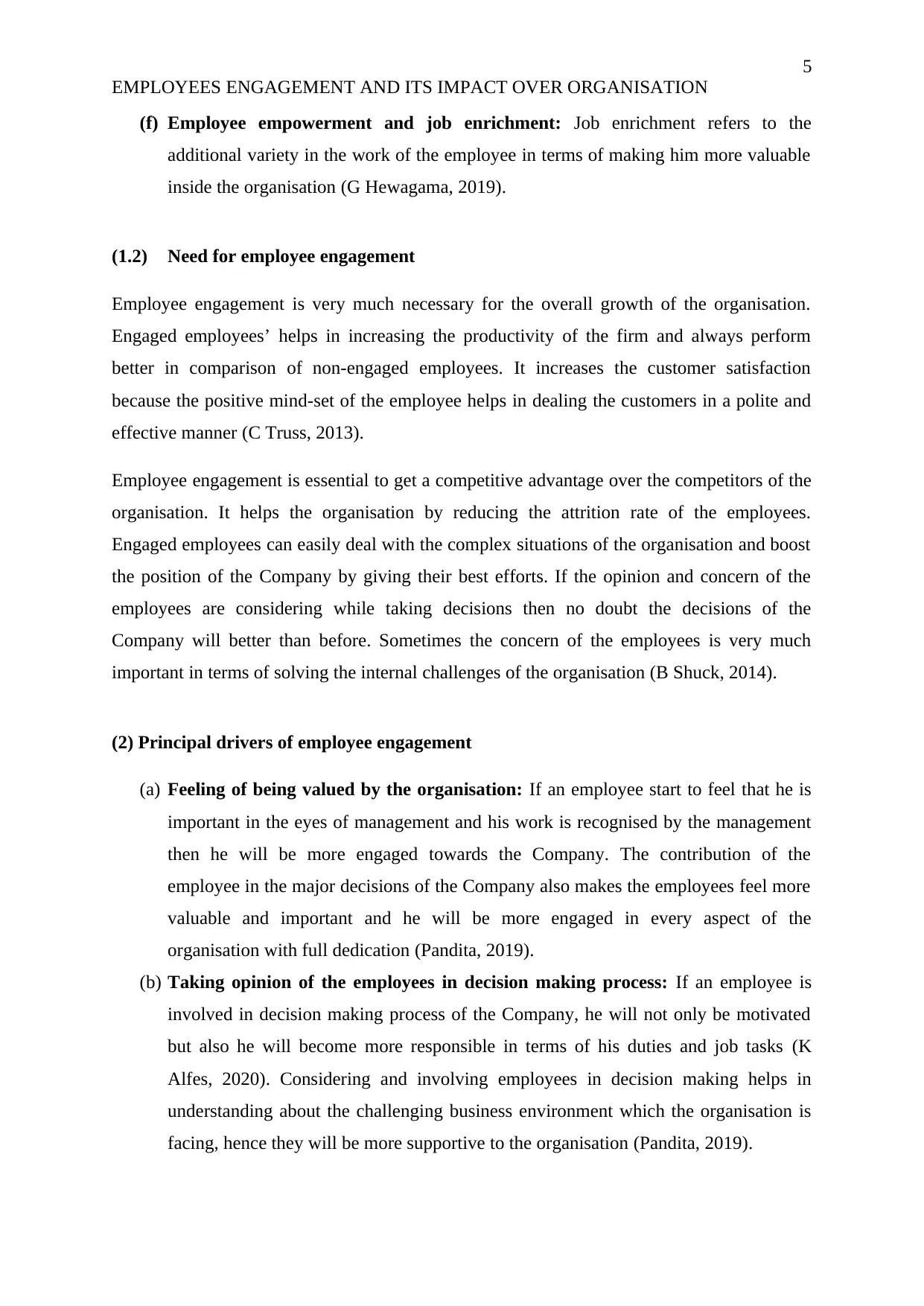
5
EMPLOYEES ENGAGEMENT AND ITS IMPACT OVER ORGANISATION
(f) Employee empowerment and job enrichment: Job enrichment refers to the
additional variety in the work of the employee in terms of making him more valuable
inside the organisation (G Hewagama, 2019).
(1.2) Need for employee engagement
Employee engagement is very much necessary for the overall growth of the organisation.
Engaged employees’ helps in increasing the productivity of the firm and always perform
better in comparison of non-engaged employees. It increases the customer satisfaction
because the positive mind-set of the employee helps in dealing the customers in a polite and
effective manner (C Truss, 2013).
Employee engagement is essential to get a competitive advantage over the competitors of the
organisation. It helps the organisation by reducing the attrition rate of the employees.
Engaged employees can easily deal with the complex situations of the organisation and boost
the position of the Company by giving their best efforts. If the opinion and concern of the
employees are considering while taking decisions then no doubt the decisions of the
Company will better than before. Sometimes the concern of the employees is very much
important in terms of solving the internal challenges of the organisation (B Shuck, 2014).
(2) Principal drivers of employee engagement
(a) Feeling of being valued by the organisation: If an employee start to feel that he is
important in the eyes of management and his work is recognised by the management
then he will be more engaged towards the Company. The contribution of the
employee in the major decisions of the Company also makes the employees feel more
valuable and important and he will be more engaged in every aspect of the
organisation with full dedication (Pandita, 2019).
(b) Taking opinion of the employees in decision making process: If an employee is
involved in decision making process of the Company, he will not only be motivated
but also he will become more responsible in terms of his duties and job tasks (K
Alfes, 2020). Considering and involving employees in decision making helps in
understanding about the challenging business environment which the organisation is
facing, hence they will be more supportive to the organisation (Pandita, 2019).
EMPLOYEES ENGAGEMENT AND ITS IMPACT OVER ORGANISATION
(f) Employee empowerment and job enrichment: Job enrichment refers to the
additional variety in the work of the employee in terms of making him more valuable
inside the organisation (G Hewagama, 2019).
(1.2) Need for employee engagement
Employee engagement is very much necessary for the overall growth of the organisation.
Engaged employees’ helps in increasing the productivity of the firm and always perform
better in comparison of non-engaged employees. It increases the customer satisfaction
because the positive mind-set of the employee helps in dealing the customers in a polite and
effective manner (C Truss, 2013).
Employee engagement is essential to get a competitive advantage over the competitors of the
organisation. It helps the organisation by reducing the attrition rate of the employees.
Engaged employees can easily deal with the complex situations of the organisation and boost
the position of the Company by giving their best efforts. If the opinion and concern of the
employees are considering while taking decisions then no doubt the decisions of the
Company will better than before. Sometimes the concern of the employees is very much
important in terms of solving the internal challenges of the organisation (B Shuck, 2014).
(2) Principal drivers of employee engagement
(a) Feeling of being valued by the organisation: If an employee start to feel that he is
important in the eyes of management and his work is recognised by the management
then he will be more engaged towards the Company. The contribution of the
employee in the major decisions of the Company also makes the employees feel more
valuable and important and he will be more engaged in every aspect of the
organisation with full dedication (Pandita, 2019).
(b) Taking opinion of the employees in decision making process: If an employee is
involved in decision making process of the Company, he will not only be motivated
but also he will become more responsible in terms of his duties and job tasks (K
Alfes, 2020). Considering and involving employees in decision making helps in
understanding about the challenging business environment which the organisation is
facing, hence they will be more supportive to the organisation (Pandita, 2019).
⊘ This is a preview!⊘
Do you want full access?
Subscribe today to unlock all pages.

Trusted by 1+ million students worldwide
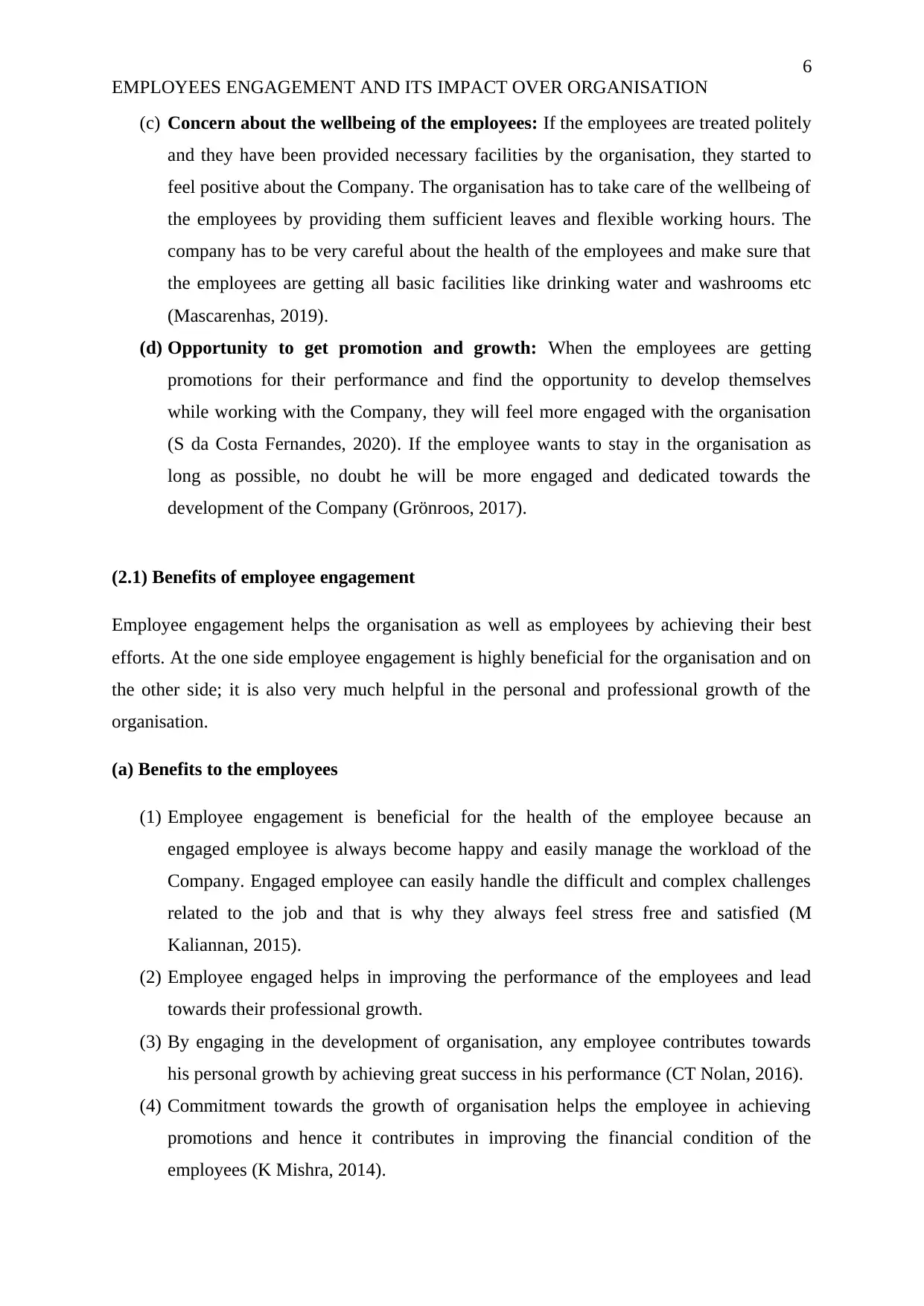
6
EMPLOYEES ENGAGEMENT AND ITS IMPACT OVER ORGANISATION
(c) Concern about the wellbeing of the employees: If the employees are treated politely
and they have been provided necessary facilities by the organisation, they started to
feel positive about the Company. The organisation has to take care of the wellbeing of
the employees by providing them sufficient leaves and flexible working hours. The
company has to be very careful about the health of the employees and make sure that
the employees are getting all basic facilities like drinking water and washrooms etc
(Mascarenhas, 2019).
(d) Opportunity to get promotion and growth: When the employees are getting
promotions for their performance and find the opportunity to develop themselves
while working with the Company, they will feel more engaged with the organisation
(S da Costa Fernandes, 2020). If the employee wants to stay in the organisation as
long as possible, no doubt he will be more engaged and dedicated towards the
development of the Company (Grönroos, 2017).
(2.1) Benefits of employee engagement
Employee engagement helps the organisation as well as employees by achieving their best
efforts. At the one side employee engagement is highly beneficial for the organisation and on
the other side; it is also very much helpful in the personal and professional growth of the
organisation.
(a) Benefits to the employees
(1) Employee engagement is beneficial for the health of the employee because an
engaged employee is always become happy and easily manage the workload of the
Company. Engaged employee can easily handle the difficult and complex challenges
related to the job and that is why they always feel stress free and satisfied (M
Kaliannan, 2015).
(2) Employee engaged helps in improving the performance of the employees and lead
towards their professional growth.
(3) By engaging in the development of organisation, any employee contributes towards
his personal growth by achieving great success in his performance (CT Nolan, 2016).
(4) Commitment towards the growth of organisation helps the employee in achieving
promotions and hence it contributes in improving the financial condition of the
employees (K Mishra, 2014).
EMPLOYEES ENGAGEMENT AND ITS IMPACT OVER ORGANISATION
(c) Concern about the wellbeing of the employees: If the employees are treated politely
and they have been provided necessary facilities by the organisation, they started to
feel positive about the Company. The organisation has to take care of the wellbeing of
the employees by providing them sufficient leaves and flexible working hours. The
company has to be very careful about the health of the employees and make sure that
the employees are getting all basic facilities like drinking water and washrooms etc
(Mascarenhas, 2019).
(d) Opportunity to get promotion and growth: When the employees are getting
promotions for their performance and find the opportunity to develop themselves
while working with the Company, they will feel more engaged with the organisation
(S da Costa Fernandes, 2020). If the employee wants to stay in the organisation as
long as possible, no doubt he will be more engaged and dedicated towards the
development of the Company (Grönroos, 2017).
(2.1) Benefits of employee engagement
Employee engagement helps the organisation as well as employees by achieving their best
efforts. At the one side employee engagement is highly beneficial for the organisation and on
the other side; it is also very much helpful in the personal and professional growth of the
organisation.
(a) Benefits to the employees
(1) Employee engagement is beneficial for the health of the employee because an
engaged employee is always become happy and easily manage the workload of the
Company. Engaged employee can easily handle the difficult and complex challenges
related to the job and that is why they always feel stress free and satisfied (M
Kaliannan, 2015).
(2) Employee engaged helps in improving the performance of the employees and lead
towards their professional growth.
(3) By engaging in the development of organisation, any employee contributes towards
his personal growth by achieving great success in his performance (CT Nolan, 2016).
(4) Commitment towards the growth of organisation helps the employee in achieving
promotions and hence it contributes in improving the financial condition of the
employees (K Mishra, 2014).
Paraphrase This Document
Need a fresh take? Get an instant paraphrase of this document with our AI Paraphraser
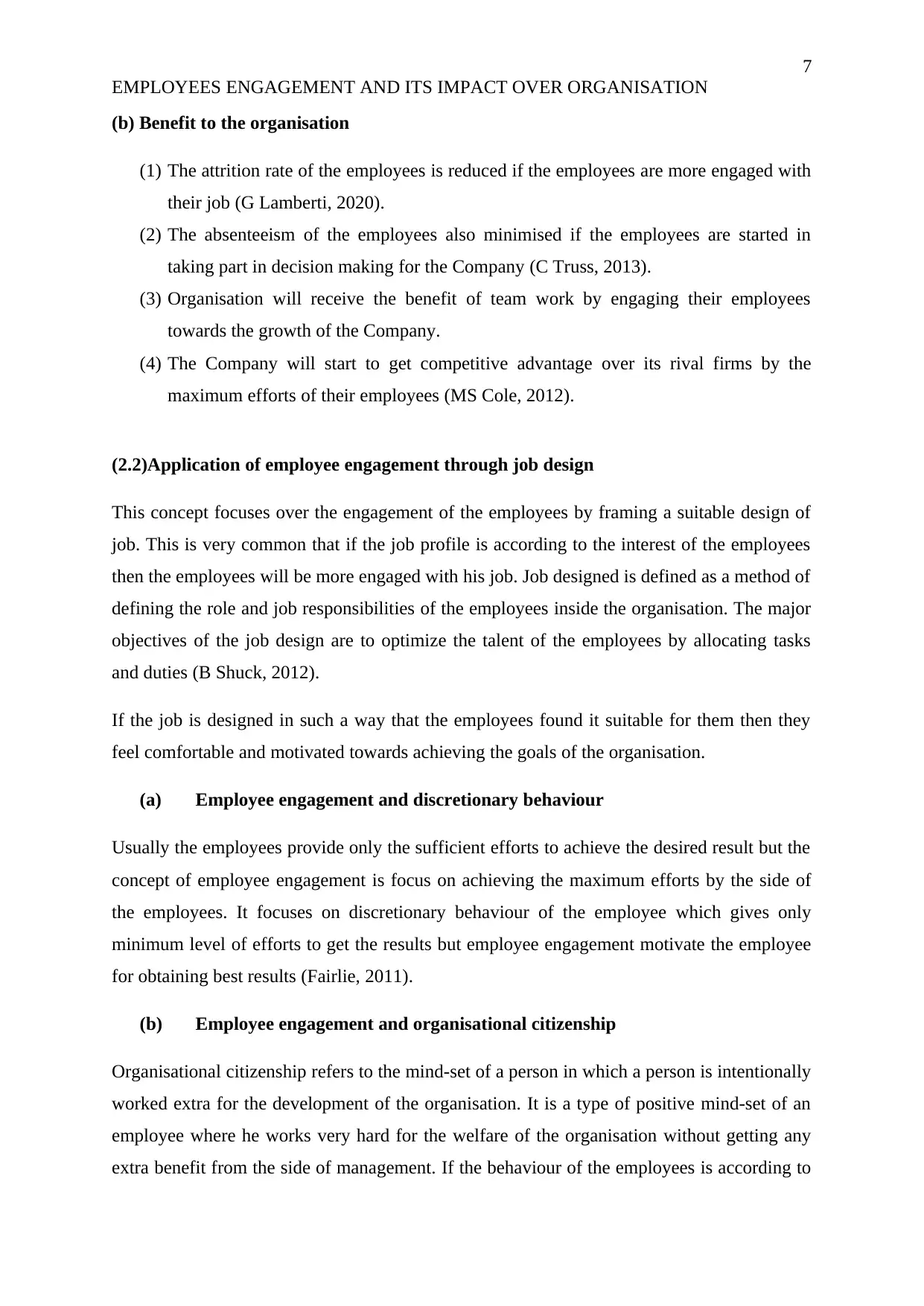
7
EMPLOYEES ENGAGEMENT AND ITS IMPACT OVER ORGANISATION
(b) Benefit to the organisation
(1) The attrition rate of the employees is reduced if the employees are more engaged with
their job (G Lamberti, 2020).
(2) The absenteeism of the employees also minimised if the employees are started in
taking part in decision making for the Company (C Truss, 2013).
(3) Organisation will receive the benefit of team work by engaging their employees
towards the growth of the Company.
(4) The Company will start to get competitive advantage over its rival firms by the
maximum efforts of their employees (MS Cole, 2012).
(2.2)Application of employee engagement through job design
This concept focuses over the engagement of the employees by framing a suitable design of
job. This is very common that if the job profile is according to the interest of the employees
then the employees will be more engaged with his job. Job designed is defined as a method of
defining the role and job responsibilities of the employees inside the organisation. The major
objectives of the job design are to optimize the talent of the employees by allocating tasks
and duties (B Shuck, 2012).
If the job is designed in such a way that the employees found it suitable for them then they
feel comfortable and motivated towards achieving the goals of the organisation.
(a) Employee engagement and discretionary behaviour
Usually the employees provide only the sufficient efforts to achieve the desired result but the
concept of employee engagement is focus on achieving the maximum efforts by the side of
the employees. It focuses on discretionary behaviour of the employee which gives only
minimum level of efforts to get the results but employee engagement motivate the employee
for obtaining best results (Fairlie, 2011).
(b) Employee engagement and organisational citizenship
Organisational citizenship refers to the mind-set of a person in which a person is intentionally
worked extra for the development of the organisation. It is a type of positive mind-set of an
employee where he works very hard for the welfare of the organisation without getting any
extra benefit from the side of management. If the behaviour of the employees is according to
EMPLOYEES ENGAGEMENT AND ITS IMPACT OVER ORGANISATION
(b) Benefit to the organisation
(1) The attrition rate of the employees is reduced if the employees are more engaged with
their job (G Lamberti, 2020).
(2) The absenteeism of the employees also minimised if the employees are started in
taking part in decision making for the Company (C Truss, 2013).
(3) Organisation will receive the benefit of team work by engaging their employees
towards the growth of the Company.
(4) The Company will start to get competitive advantage over its rival firms by the
maximum efforts of their employees (MS Cole, 2012).
(2.2)Application of employee engagement through job design
This concept focuses over the engagement of the employees by framing a suitable design of
job. This is very common that if the job profile is according to the interest of the employees
then the employees will be more engaged with his job. Job designed is defined as a method of
defining the role and job responsibilities of the employees inside the organisation. The major
objectives of the job design are to optimize the talent of the employees by allocating tasks
and duties (B Shuck, 2012).
If the job is designed in such a way that the employees found it suitable for them then they
feel comfortable and motivated towards achieving the goals of the organisation.
(a) Employee engagement and discretionary behaviour
Usually the employees provide only the sufficient efforts to achieve the desired result but the
concept of employee engagement is focus on achieving the maximum efforts by the side of
the employees. It focuses on discretionary behaviour of the employee which gives only
minimum level of efforts to get the results but employee engagement motivate the employee
for obtaining best results (Fairlie, 2011).
(b) Employee engagement and organisational citizenship
Organisational citizenship refers to the mind-set of a person in which a person is intentionally
worked extra for the development of the organisation. It is a type of positive mind-set of an
employee where he works very hard for the welfare of the organisation without getting any
extra benefit from the side of management. If the behaviour of the employees is according to
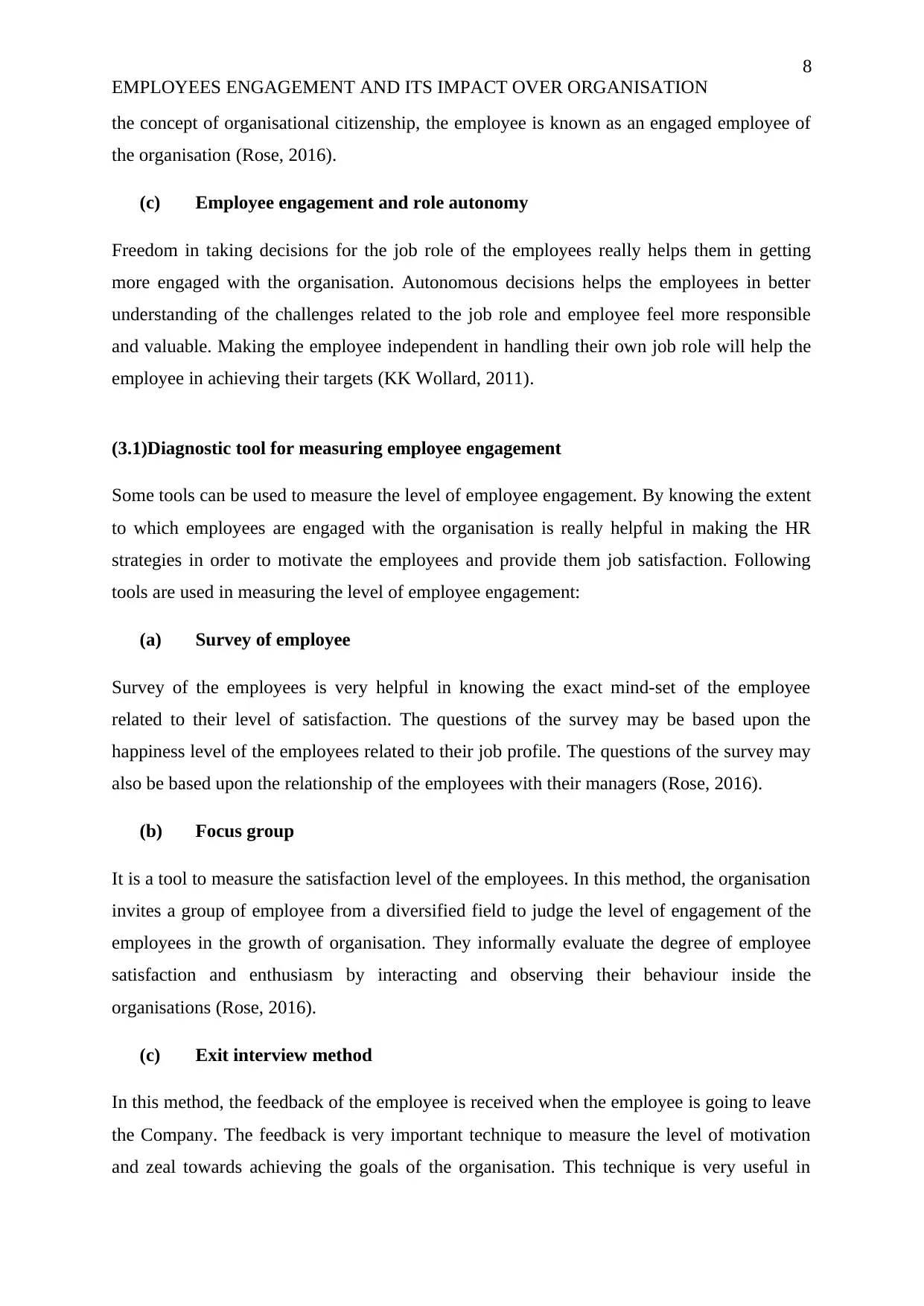
8
EMPLOYEES ENGAGEMENT AND ITS IMPACT OVER ORGANISATION
the concept of organisational citizenship, the employee is known as an engaged employee of
the organisation (Rose, 2016).
(c) Employee engagement and role autonomy
Freedom in taking decisions for the job role of the employees really helps them in getting
more engaged with the organisation. Autonomous decisions helps the employees in better
understanding of the challenges related to the job role and employee feel more responsible
and valuable. Making the employee independent in handling their own job role will help the
employee in achieving their targets (KK Wollard, 2011).
(3.1)Diagnostic tool for measuring employee engagement
Some tools can be used to measure the level of employee engagement. By knowing the extent
to which employees are engaged with the organisation is really helpful in making the HR
strategies in order to motivate the employees and provide them job satisfaction. Following
tools are used in measuring the level of employee engagement:
(a) Survey of employee
Survey of the employees is very helpful in knowing the exact mind-set of the employee
related to their level of satisfaction. The questions of the survey may be based upon the
happiness level of the employees related to their job profile. The questions of the survey may
also be based upon the relationship of the employees with their managers (Rose, 2016).
(b) Focus group
It is a tool to measure the satisfaction level of the employees. In this method, the organisation
invites a group of employee from a diversified field to judge the level of engagement of the
employees in the growth of organisation. They informally evaluate the degree of employee
satisfaction and enthusiasm by interacting and observing their behaviour inside the
organisations (Rose, 2016).
(c) Exit interview method
In this method, the feedback of the employee is received when the employee is going to leave
the Company. The feedback is very important technique to measure the level of motivation
and zeal towards achieving the goals of the organisation. This technique is very useful in
EMPLOYEES ENGAGEMENT AND ITS IMPACT OVER ORGANISATION
the concept of organisational citizenship, the employee is known as an engaged employee of
the organisation (Rose, 2016).
(c) Employee engagement and role autonomy
Freedom in taking decisions for the job role of the employees really helps them in getting
more engaged with the organisation. Autonomous decisions helps the employees in better
understanding of the challenges related to the job role and employee feel more responsible
and valuable. Making the employee independent in handling their own job role will help the
employee in achieving their targets (KK Wollard, 2011).
(3.1)Diagnostic tool for measuring employee engagement
Some tools can be used to measure the level of employee engagement. By knowing the extent
to which employees are engaged with the organisation is really helpful in making the HR
strategies in order to motivate the employees and provide them job satisfaction. Following
tools are used in measuring the level of employee engagement:
(a) Survey of employee
Survey of the employees is very helpful in knowing the exact mind-set of the employee
related to their level of satisfaction. The questions of the survey may be based upon the
happiness level of the employees related to their job profile. The questions of the survey may
also be based upon the relationship of the employees with their managers (Rose, 2016).
(b) Focus group
It is a tool to measure the satisfaction level of the employees. In this method, the organisation
invites a group of employee from a diversified field to judge the level of engagement of the
employees in the growth of organisation. They informally evaluate the degree of employee
satisfaction and enthusiasm by interacting and observing their behaviour inside the
organisations (Rose, 2016).
(c) Exit interview method
In this method, the feedback of the employee is received when the employee is going to leave
the Company. The feedback is very important technique to measure the level of motivation
and zeal towards achieving the goals of the organisation. This technique is very useful in
⊘ This is a preview!⊘
Do you want full access?
Subscribe today to unlock all pages.

Trusted by 1+ million students worldwide
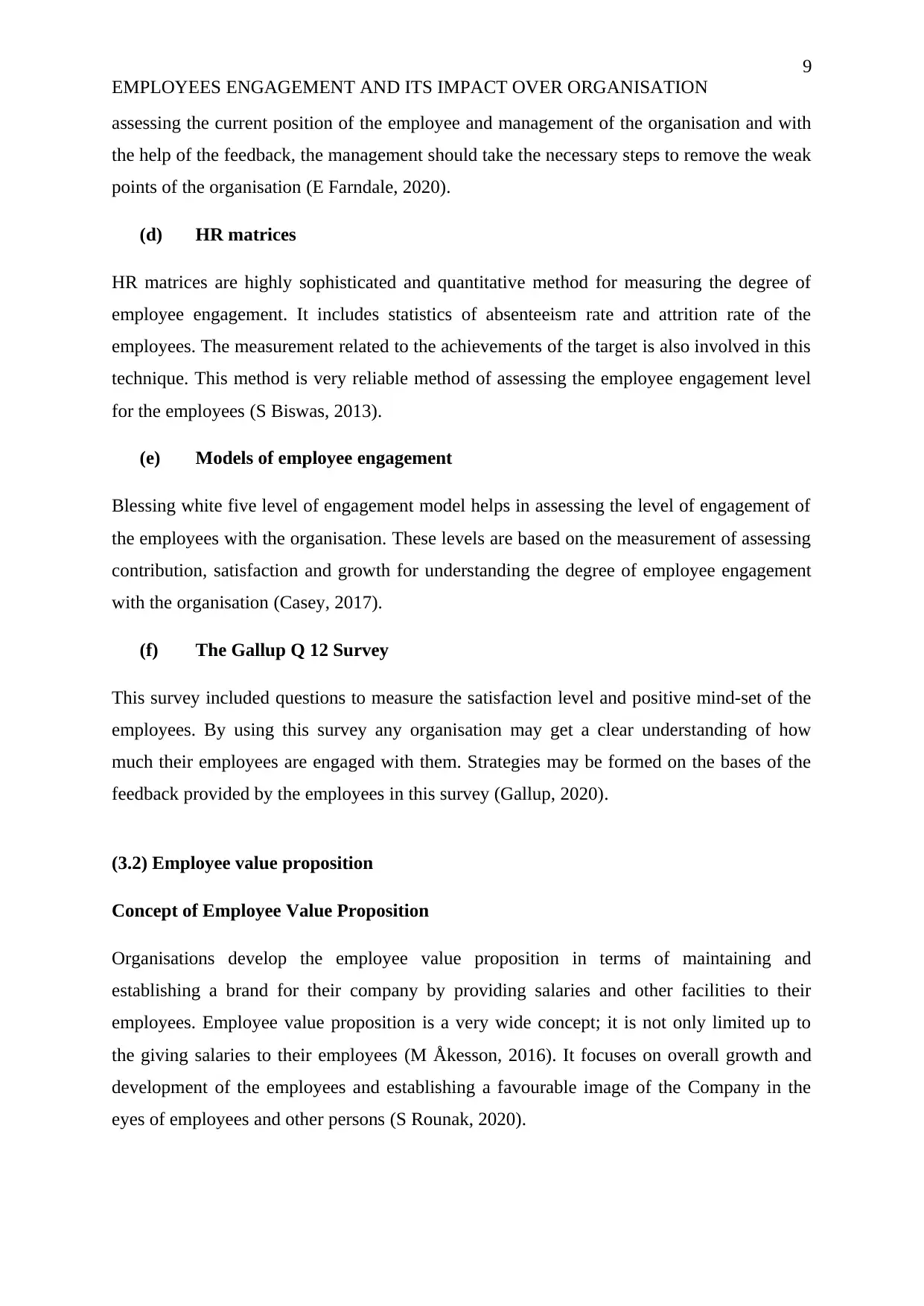
9
EMPLOYEES ENGAGEMENT AND ITS IMPACT OVER ORGANISATION
assessing the current position of the employee and management of the organisation and with
the help of the feedback, the management should take the necessary steps to remove the weak
points of the organisation (E Farndale, 2020).
(d) HR matrices
HR matrices are highly sophisticated and quantitative method for measuring the degree of
employee engagement. It includes statistics of absenteeism rate and attrition rate of the
employees. The measurement related to the achievements of the target is also involved in this
technique. This method is very reliable method of assessing the employee engagement level
for the employees (S Biswas, 2013).
(e) Models of employee engagement
Blessing white five level of engagement model helps in assessing the level of engagement of
the employees with the organisation. These levels are based on the measurement of assessing
contribution, satisfaction and growth for understanding the degree of employee engagement
with the organisation (Casey, 2017).
(f) The Gallup Q 12 Survey
This survey included questions to measure the satisfaction level and positive mind-set of the
employees. By using this survey any organisation may get a clear understanding of how
much their employees are engaged with them. Strategies may be formed on the bases of the
feedback provided by the employees in this survey (Gallup, 2020).
(3.2) Employee value proposition
Concept of Employee Value Proposition
Organisations develop the employee value proposition in terms of maintaining and
establishing a brand for their company by providing salaries and other facilities to their
employees. Employee value proposition is a very wide concept; it is not only limited up to
the giving salaries to their employees (M Åkesson, 2016). It focuses on overall growth and
development of the employees and establishing a favourable image of the Company in the
eyes of employees and other persons (S Rounak, 2020).
EMPLOYEES ENGAGEMENT AND ITS IMPACT OVER ORGANISATION
assessing the current position of the employee and management of the organisation and with
the help of the feedback, the management should take the necessary steps to remove the weak
points of the organisation (E Farndale, 2020).
(d) HR matrices
HR matrices are highly sophisticated and quantitative method for measuring the degree of
employee engagement. It includes statistics of absenteeism rate and attrition rate of the
employees. The measurement related to the achievements of the target is also involved in this
technique. This method is very reliable method of assessing the employee engagement level
for the employees (S Biswas, 2013).
(e) Models of employee engagement
Blessing white five level of engagement model helps in assessing the level of engagement of
the employees with the organisation. These levels are based on the measurement of assessing
contribution, satisfaction and growth for understanding the degree of employee engagement
with the organisation (Casey, 2017).
(f) The Gallup Q 12 Survey
This survey included questions to measure the satisfaction level and positive mind-set of the
employees. By using this survey any organisation may get a clear understanding of how
much their employees are engaged with them. Strategies may be formed on the bases of the
feedback provided by the employees in this survey (Gallup, 2020).
(3.2) Employee value proposition
Concept of Employee Value Proposition
Organisations develop the employee value proposition in terms of maintaining and
establishing a brand for their company by providing salaries and other facilities to their
employees. Employee value proposition is a very wide concept; it is not only limited up to
the giving salaries to their employees (M Åkesson, 2016). It focuses on overall growth and
development of the employees and establishing a favourable image of the Company in the
eyes of employees and other persons (S Rounak, 2020).
Paraphrase This Document
Need a fresh take? Get an instant paraphrase of this document with our AI Paraphraser
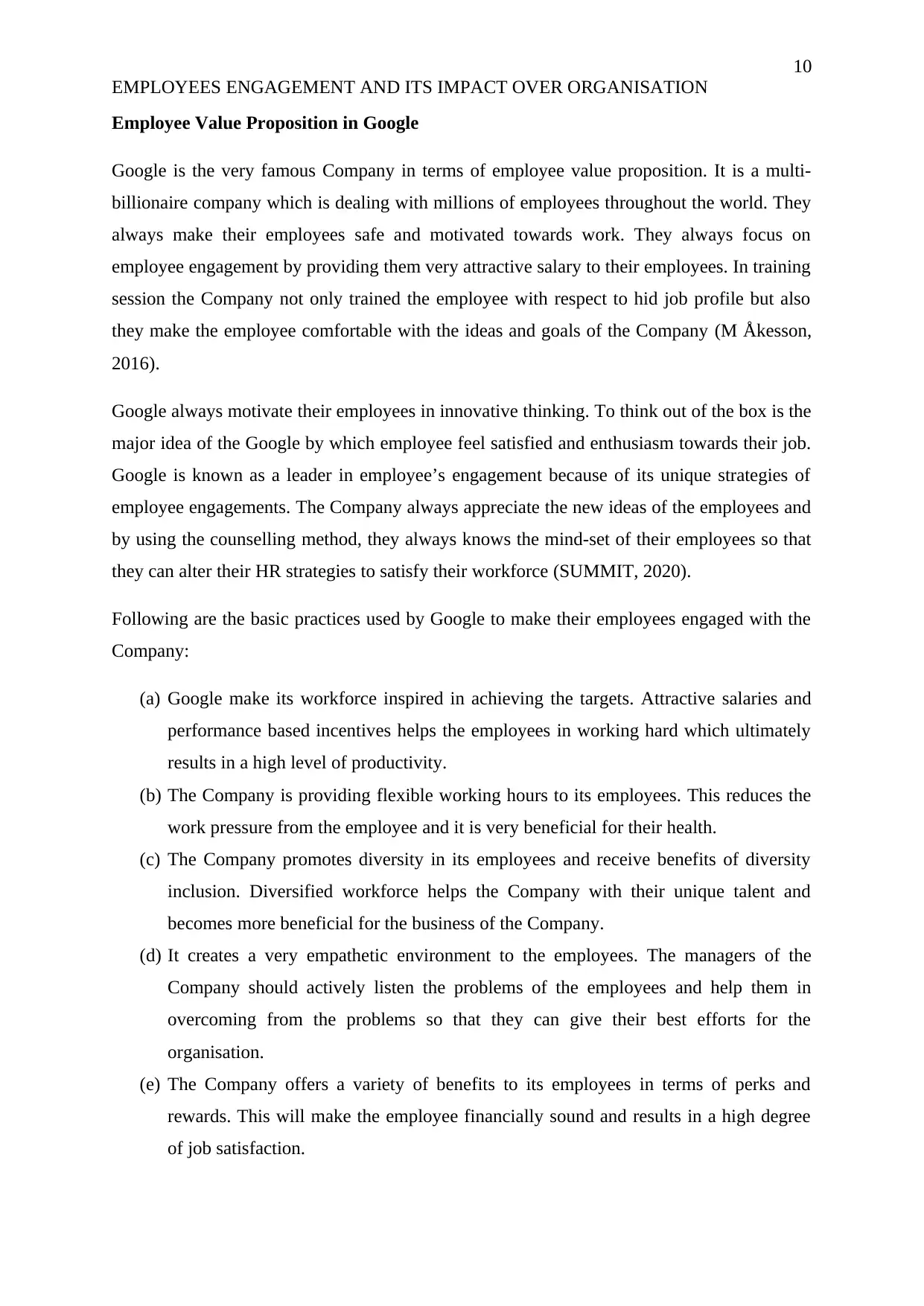
10
EMPLOYEES ENGAGEMENT AND ITS IMPACT OVER ORGANISATION
Employee Value Proposition in Google
Google is the very famous Company in terms of employee value proposition. It is a multi-
billionaire company which is dealing with millions of employees throughout the world. They
always make their employees safe and motivated towards work. They always focus on
employee engagement by providing them very attractive salary to their employees. In training
session the Company not only trained the employee with respect to hid job profile but also
they make the employee comfortable with the ideas and goals of the Company (M Åkesson,
2016).
Google always motivate their employees in innovative thinking. To think out of the box is the
major idea of the Google by which employee feel satisfied and enthusiasm towards their job.
Google is known as a leader in employee’s engagement because of its unique strategies of
employee engagements. The Company always appreciate the new ideas of the employees and
by using the counselling method, they always knows the mind-set of their employees so that
they can alter their HR strategies to satisfy their workforce (SUMMIT, 2020).
Following are the basic practices used by Google to make their employees engaged with the
Company:
(a) Google make its workforce inspired in achieving the targets. Attractive salaries and
performance based incentives helps the employees in working hard which ultimately
results in a high level of productivity.
(b) The Company is providing flexible working hours to its employees. This reduces the
work pressure from the employee and it is very beneficial for their health.
(c) The Company promotes diversity in its employees and receive benefits of diversity
inclusion. Diversified workforce helps the Company with their unique talent and
becomes more beneficial for the business of the Company.
(d) It creates a very empathetic environment to the employees. The managers of the
Company should actively listen the problems of the employees and help them in
overcoming from the problems so that they can give their best efforts for the
organisation.
(e) The Company offers a variety of benefits to its employees in terms of perks and
rewards. This will make the employee financially sound and results in a high degree
of job satisfaction.
EMPLOYEES ENGAGEMENT AND ITS IMPACT OVER ORGANISATION
Employee Value Proposition in Google
Google is the very famous Company in terms of employee value proposition. It is a multi-
billionaire company which is dealing with millions of employees throughout the world. They
always make their employees safe and motivated towards work. They always focus on
employee engagement by providing them very attractive salary to their employees. In training
session the Company not only trained the employee with respect to hid job profile but also
they make the employee comfortable with the ideas and goals of the Company (M Åkesson,
2016).
Google always motivate their employees in innovative thinking. To think out of the box is the
major idea of the Google by which employee feel satisfied and enthusiasm towards their job.
Google is known as a leader in employee’s engagement because of its unique strategies of
employee engagements. The Company always appreciate the new ideas of the employees and
by using the counselling method, they always knows the mind-set of their employees so that
they can alter their HR strategies to satisfy their workforce (SUMMIT, 2020).
Following are the basic practices used by Google to make their employees engaged with the
Company:
(a) Google make its workforce inspired in achieving the targets. Attractive salaries and
performance based incentives helps the employees in working hard which ultimately
results in a high level of productivity.
(b) The Company is providing flexible working hours to its employees. This reduces the
work pressure from the employee and it is very beneficial for their health.
(c) The Company promotes diversity in its employees and receive benefits of diversity
inclusion. Diversified workforce helps the Company with their unique talent and
becomes more beneficial for the business of the Company.
(d) It creates a very empathetic environment to the employees. The managers of the
Company should actively listen the problems of the employees and help them in
overcoming from the problems so that they can give their best efforts for the
organisation.
(e) The Company offers a variety of benefits to its employees in terms of perks and
rewards. This will make the employee financially sound and results in a high degree
of job satisfaction.
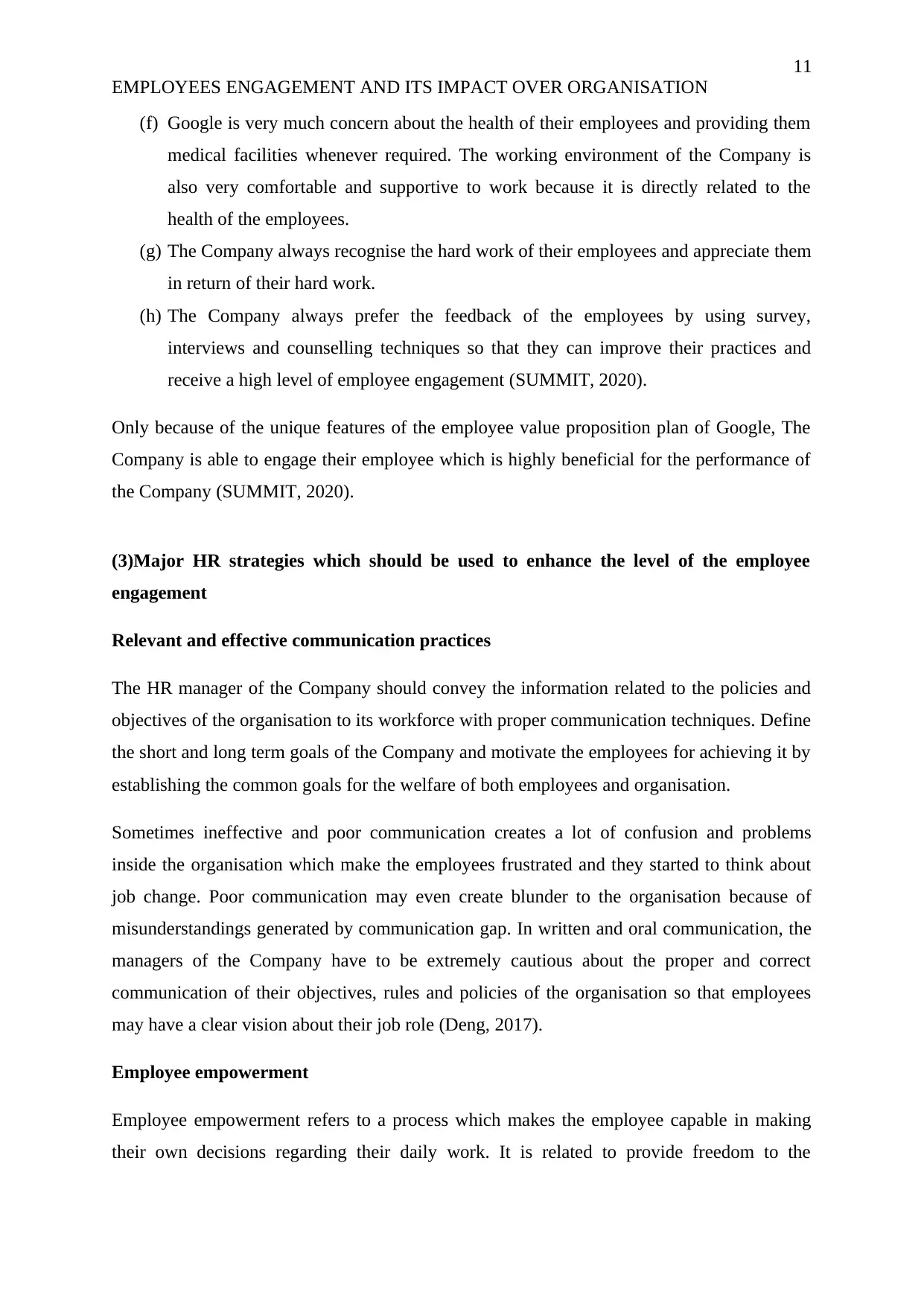
11
EMPLOYEES ENGAGEMENT AND ITS IMPACT OVER ORGANISATION
(f) Google is very much concern about the health of their employees and providing them
medical facilities whenever required. The working environment of the Company is
also very comfortable and supportive to work because it is directly related to the
health of the employees.
(g) The Company always recognise the hard work of their employees and appreciate them
in return of their hard work.
(h) The Company always prefer the feedback of the employees by using survey,
interviews and counselling techniques so that they can improve their practices and
receive a high level of employee engagement (SUMMIT, 2020).
Only because of the unique features of the employee value proposition plan of Google, The
Company is able to engage their employee which is highly beneficial for the performance of
the Company (SUMMIT, 2020).
(3)Major HR strategies which should be used to enhance the level of the employee
engagement
Relevant and effective communication practices
The HR manager of the Company should convey the information related to the policies and
objectives of the organisation to its workforce with proper communication techniques. Define
the short and long term goals of the Company and motivate the employees for achieving it by
establishing the common goals for the welfare of both employees and organisation.
Sometimes ineffective and poor communication creates a lot of confusion and problems
inside the organisation which make the employees frustrated and they started to think about
job change. Poor communication may even create blunder to the organisation because of
misunderstandings generated by communication gap. In written and oral communication, the
managers of the Company have to be extremely cautious about the proper and correct
communication of their objectives, rules and policies of the organisation so that employees
may have a clear vision about their job role (Deng, 2017).
Employee empowerment
Employee empowerment refers to a process which makes the employee capable in making
their own decisions regarding their daily work. It is related to provide freedom to the
EMPLOYEES ENGAGEMENT AND ITS IMPACT OVER ORGANISATION
(f) Google is very much concern about the health of their employees and providing them
medical facilities whenever required. The working environment of the Company is
also very comfortable and supportive to work because it is directly related to the
health of the employees.
(g) The Company always recognise the hard work of their employees and appreciate them
in return of their hard work.
(h) The Company always prefer the feedback of the employees by using survey,
interviews and counselling techniques so that they can improve their practices and
receive a high level of employee engagement (SUMMIT, 2020).
Only because of the unique features of the employee value proposition plan of Google, The
Company is able to engage their employee which is highly beneficial for the performance of
the Company (SUMMIT, 2020).
(3)Major HR strategies which should be used to enhance the level of the employee
engagement
Relevant and effective communication practices
The HR manager of the Company should convey the information related to the policies and
objectives of the organisation to its workforce with proper communication techniques. Define
the short and long term goals of the Company and motivate the employees for achieving it by
establishing the common goals for the welfare of both employees and organisation.
Sometimes ineffective and poor communication creates a lot of confusion and problems
inside the organisation which make the employees frustrated and they started to think about
job change. Poor communication may even create blunder to the organisation because of
misunderstandings generated by communication gap. In written and oral communication, the
managers of the Company have to be extremely cautious about the proper and correct
communication of their objectives, rules and policies of the organisation so that employees
may have a clear vision about their job role (Deng, 2017).
Employee empowerment
Employee empowerment refers to a process which makes the employee capable in making
their own decisions regarding their daily work. It is related to provide freedom to the
⊘ This is a preview!⊘
Do you want full access?
Subscribe today to unlock all pages.

Trusted by 1+ million students worldwide
1 out of 19
Related Documents
Your All-in-One AI-Powered Toolkit for Academic Success.
+13062052269
info@desklib.com
Available 24*7 on WhatsApp / Email
![[object Object]](/_next/static/media/star-bottom.7253800d.svg)
Unlock your academic potential
Copyright © 2020–2025 A2Z Services. All Rights Reserved. Developed and managed by ZUCOL.





